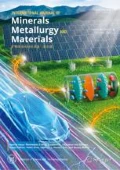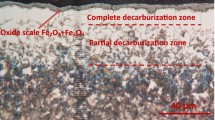Abstract
for ultra-low-carbon (ULC) steel production, the higher oxygen content before Ruhrstahl-Heraeus (RH) decarburization (de-C) treatment could shorten the de-C time in the RH degasser. However, this would lead to oxidation rates being exceeded by molten steel production, affecting ULC steel surface quality. In this work, a carbon powder addition (CPA) process was proposed to reduce the dissolved oxygen content at the end of RH de-C through addition of carbon powder to molten steel in the vacuum vessel. Carbon and oxygen behavior during the CPA and conventional process was then studied. The results demonstrated that the de-C rate with CPA was lower compared to the conventional process, but the carbon content at the end of de-C presented no difference. The de-C reaction for CPA process took place in the four reaction sites: (1) within the bulk steel where the spontaneous CO bubbles form; (2) splashing area on the liquid steel surface; (3) Ar bubble surface; (4) molten steel surface. The CPA process could significantly reduce the dissolved oxygen content at the end of de-C, the sum content of FeO and MnO in the slag, the aluminum consumption, and the defect rate of rolled products. This was beneficial in improving ULC steel cleanliness.
Similar content being viewed by others
References
M. Takahashi, H. Matsumoto, and T. Saito, Mechanism of de-C in RH degasser, ISIJ Int., 35(1995), No. 12, p. 1452.
G.J. Chen and S.P. He, Circulation flow rate and de-C in the RH degasser under low atmospheric pressure, Vacuum, 153(2018), p. 132.
Y.H. Li, Y.P. Bao, R. Wang, L.F. Ma, and J.S. Liu, Modeling study on the flow patterns of gas-liquid flow for fast de-C during the RH process, Int. J. Miner. Metall. Mater, 25(2018), No. 2, p. 153.
J. Guo, S.S. Cheng, H.J. Guo, and Y.G. Mei, Novel mechanism for the modification of Al2O3-based inclusions in ultra-low carbon Al-killed steel considering the effects of magnesium and calcium, Int. J. Miner. Metall. Mater, 25(2018), No. 3, p. 280.
M. Wang, Y.P. Bao, Q. Yang, L.H. Zhao, and L. Lin, Coordinated control of carbon and oxygen for ultra-low-carbon interstitial-free steel in a smelting process, Int. J. Miner. Metall. Mater, 22(2015), No. 12, p. 1252.
D.Q. Geng, J.X. Zheng, K. Wang, P. Wang, R.Q. Liang, H.T. Liu, H. Lei, and J.C. He, Simulation on de-C and inclusion removal process in the ruhrstahl-heraeus (RH) process with ladle bottom blowing, Metall. Mater. Trans. B, 46(2015), No. 3, p. 1484.
Y.H. Li, Y.P. Bao, R. Wang, M. Min, Q.X. Huang, and Y.G. Li, Modeling of liquid level and bubble behavior in vacuum chamber of RH process, J. Iron. Steel Res. Int., 23(2016), No. 4, p. 305.
T. Kuwabara, K. Umezawa, K. Mori, and H. Watanabe, Investigation of decarburization behavior in RH-reactor and its operation improvement, Trans. Iron Steel Inst. Jpn., 28(1988), No. 4, p. 305.
B.K. Li and T. Fumitaka, Modeling of circulating flow in RH degassing vessel water model designed for two-and multi-legs operations, ISIJ Int., 40(2000), No. 12, p. 1203.
G.J. Chen and S.P. He, Mixing behavior in the RH degasser with bottom gas injection, Vacuum, 130(2016), p. 48.
H. Takechi, Metallurgical aspects on interstitial free sheet steel from industrial viewpoints, ISIJ Int., 34(1994), No. 1, p. 1.
Y.M. Qin, X.H. Wang, L.P. Li, and F.X. Huang, Effect of oxidizing slag on cleanliness of IF steel during ladle holding process, Steel Res. Int., 86(2015), No. 9, p. 1037.
E. Zinngrebe, C. Van Hoek, H. Visser, A. Westendorp, and I.H. Jung, Inclusion population evolution in Ti-alloyed Al-killed steel during secondary steelmaking process, ISIJ Int., 52(2012), No. 1, p. 52.
F. Zhang and G.Q. Li, Control of ultra low titanium in ultra low carbon Al-Si killed steel, J. Iron Steel Res. Int., 20(2013), No. 4, p. 20.
G.H. Li, B. Wang, Q. Liu, X.Z. Tian, R. Zhu, L.N. Hu, and G.G. Cheng, A process model for BOF process based on bath mixing degree, Int. J. Miner. Metall. Mater., 17(2010), No. 6, p. 715.
P.H. Li, Y.P. Bao, F. Yue, and J. Huang, BOF end-point control of ultra low carbon steel, Iron Steel, 46(2011), No. 10, p. 27.
N. Jia, Y.B. Zhang, and M.W. Wu, Deoxidation practice with high-quality carbon powder to substitute part of Ferro-Aluminum in tapping of converter, Hebei Metall., 237(2015), No. 9, p. 56.
J.L. Guo, Y.P. Bao, and M. Wang, Cleanliness of Ti-bearing Al-killed ultra-low-carbon steel during different heating processes, Int. J. Miner. Metall. Mater., 24(2017), No. 12, p. 1370.
Y. Kishimoto, K. Yamaguchi, T. Sakuraya, and T. Fujii, De-C reaction in ultra-low carbon iron melt under reduced pressure, ISIJ Int., 33(1993), No. 3, p. 791.
S. Inoue, Y. Furuno, T. Usui, and S. Miyahara, Acceleration of de-C in RH vacuum degassing process, ISIJ Int., 32(1992), No. 1, p. 120.
B.S. Liu, G.S. Zhu, H.X. Li, B.H. Li, and A.M. Cui, De-C rate of RH refining for ultra low carbon steel, Int. J. Miner. Metall. Mater., 17(2010), No. 1, p. 22.
C.Y. Liu, F.X. Huang, and X.H. Wang, The effect of refining slag and refractory on inclusion transformation in extra low oxygen steels, Metall. Mater. Trans. B, 47(2016), No. 2, p. 999.
M.A. van Ende, Y.M. Kim, M.K. Cho, J. Choi, and I.H. Jung, A kinetic model for the Ruhrstahl Heraeus (RH) degassing process, Metall. Mater. Trans. B, 42(2011), No. 3, p. 477.
Y. Higuchi, H. Ikenaga, and Y. Shirota, Effects of [C], [O] and pressure on RH vacuum de-C, Tetsu-to-Hagané, 84(1998), No. 10, p. 709.
Y.G. Park and K.W. Yi, A new numerical model for predicting carbon concentration during RH degassing treatment, ISIJ Int., 43(2007), No. 9, p. 1403.
Acknowledgements
This study was financially supported by the National Natural Science Foundation of China (No. 51874021), Fundamental Research Funds for the Central Universities of China (No. FRF-IC-18-002) and State Key Laboratory of Advanced Metallurgy Foundation of China (No. 41618019). The authors are thankful to Magang (Group) Holding Co., Ltd. for the support on the field test.
Author information
Authors and Affiliations
Corresponding author
Rights and permissions
About this article
Cite this article
Guo, Jl., Zhao, Lh., Bao, Yp. et al. Carbon and oxygen behavior in the RH degasser with carbon powder addition. Int J Miner Metall Mater 26, 681–688 (2019). https://doi.org/10.1007/s12613-019-1782-0
Received:
Revised:
Accepted:
Published:
Issue Date:
DOI: https://doi.org/10.1007/s12613-019-1782-0




